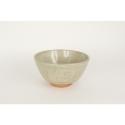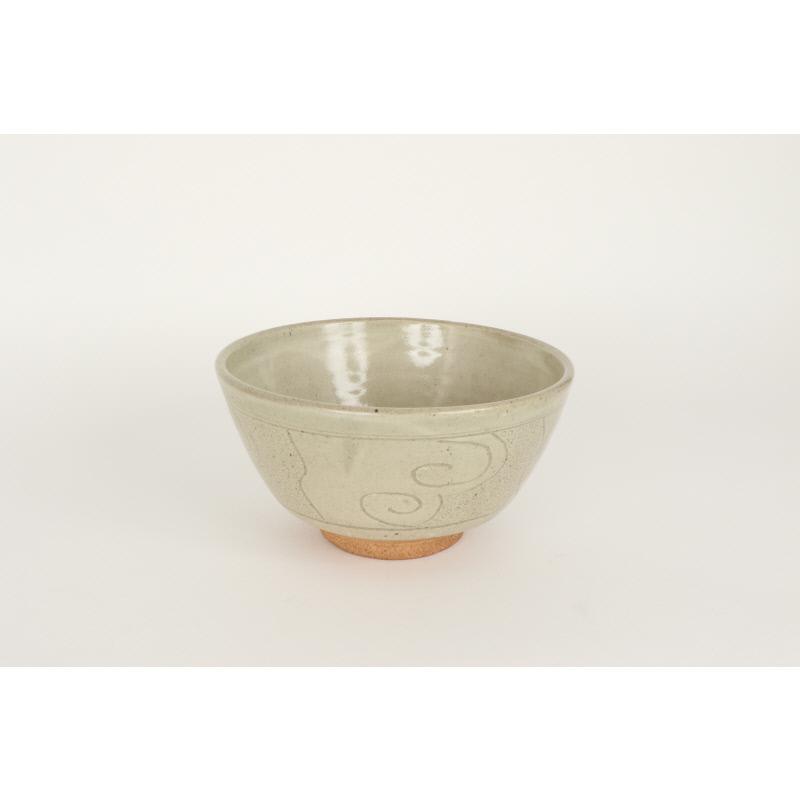Bowl
Classification(s):
Pottery
Date: c. 1951-1976
Dimensions:
150 × 276 mm (15 × 27.6 cm)
Medium: Stoneware
Object number: P542A
See Also
DescriptionLarge deep glazed stoneware bowl by Bernard Leach. Produced at the Leach Pottery in St Ives. The bowl has incised detailing in a band to the exterior of the body, with incised wavy lines and circles. The foot of the bowl has not been glazed.
The bowl is stamped to base with the Leach Pottery seal mark: an interlaced “SI” and a potters stamp: “BL” inside a square.
Label to front “P542A B. Leach £18”.
Small label to side “LBB”.
The bowl is stamped to base with the Leach Pottery seal mark: an interlaced “SI” and a potters stamp: “BL” inside a square.
Label to front “P542A B. Leach £18”.
Small label to side “LBB”.
ProvenanceThis object was originally acquired for the Inner London Education Authority’s (ILEA) ‘Circulating Design Scheme’ collection.
The collection was instigated by the London Country Council (later the Greater London Council) and the Council of Industrial Design (COID). The collection’s original purpose was concerned with the teaching and dissemination of modern, ‘good design’.
The collection was established in 1951/52 as the ‘Experiment in Design Appreciation’, later renamed the ‘Circulating Design Scheme’.
The Circulating Design Scheme lent boxed showcases to London schools. The showcases contained handling objects, material samples and interpretation on a specific subject.
COID withdrew its involvement in the Scheme in 1957. After which time, it was managed exclusively by the London County Council from 1957-1963.
After the administrative restructuring of London authorities, the Scheme was jointly managed by the Greater London Council and the Inner London Education Authority (ILEA) from 1963 – 1976.
The Scheme was operational until 1976 when the collections were withdrawn from circulation. ILEA was abolished in the late 1980s and the collection was donated to Camberwell College of Arts in 1989/90.
ILEA was responsible for secondary and tertiary education in the inner London boroughs, this included Camberwell.
The collection was instigated by the London Country Council (later the Greater London Council) and the Council of Industrial Design (COID). The collection’s original purpose was concerned with the teaching and dissemination of modern, ‘good design’.
The collection was established in 1951/52 as the ‘Experiment in Design Appreciation’, later renamed the ‘Circulating Design Scheme’.
The Circulating Design Scheme lent boxed showcases to London schools. The showcases contained handling objects, material samples and interpretation on a specific subject.
COID withdrew its involvement in the Scheme in 1957. After which time, it was managed exclusively by the London County Council from 1957-1963.
After the administrative restructuring of London authorities, the Scheme was jointly managed by the Greater London Council and the Inner London Education Authority (ILEA) from 1963 – 1976.
The Scheme was operational until 1976 when the collections were withdrawn from circulation. ILEA was abolished in the late 1980s and the collection was donated to Camberwell College of Arts in 1989/90.
ILEA was responsible for secondary and tertiary education in the inner London boroughs, this included Camberwell.
NotesBernard Leach is considered the patriarch of British craft ceramics; his workshop at St Ives became an exemplar for the movement. Founded in 1920 by Leach and Japanese potter Shoji Hamada, the Leach Pottery is among the most respected and influential potteries in the world, with a creative principle of East/West exchange. Studio pottery was seen as the antithesis to the aesthetic of mass-produced ceramics and refined finishes, charming designs, and 19th century shapes. Bernard Leach helped to reinvigorate domestic ceramic practice by looking to the Far East for inspiration. Leach produced a range of ceramics including stoneware, slipware and Raku ware, as well as authoring a seminal title 'A Potter's Book', published in 1940. By the 1960s Leach was acknowledged as a master craftsman and his work was accepted as the standard by which others were judged. Bernard Leach was married to Janet Leach, who also ran and produced work at the Leach Pottery, St Ives.




